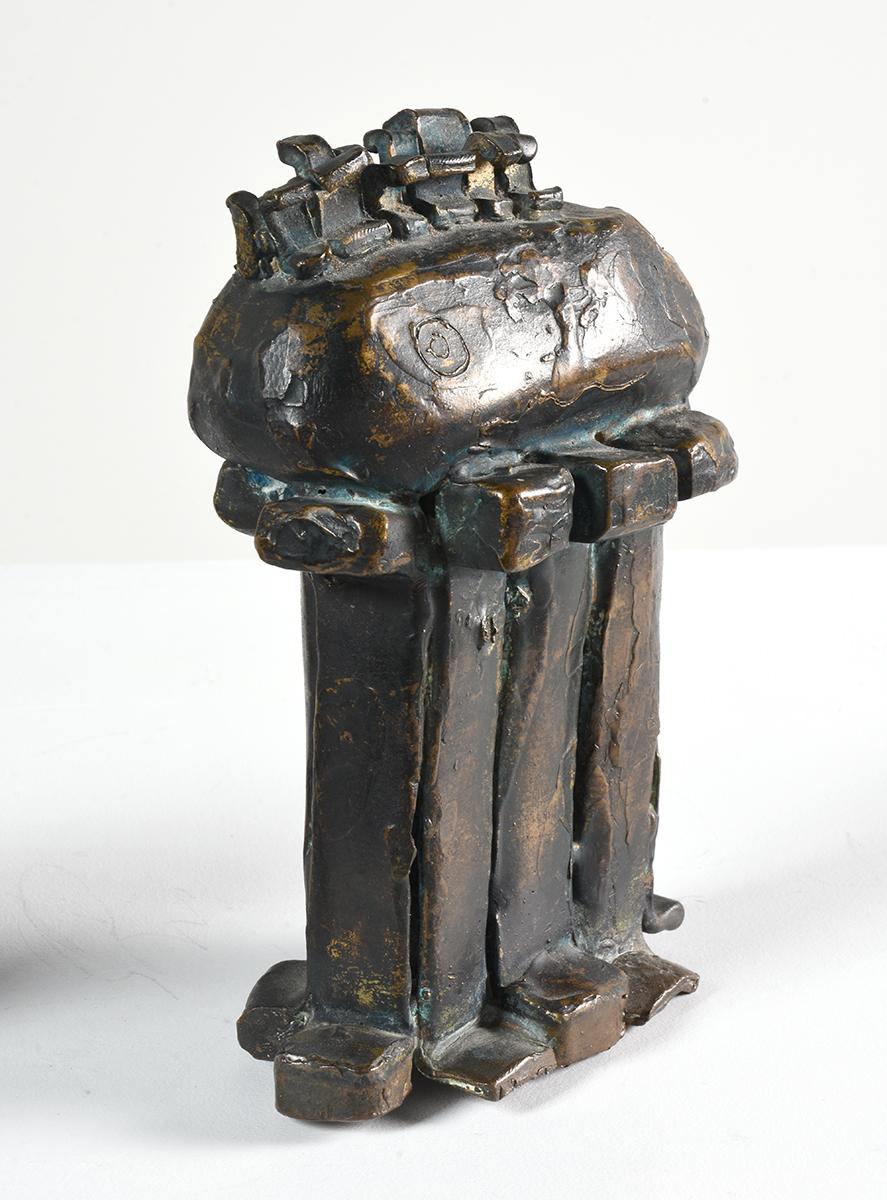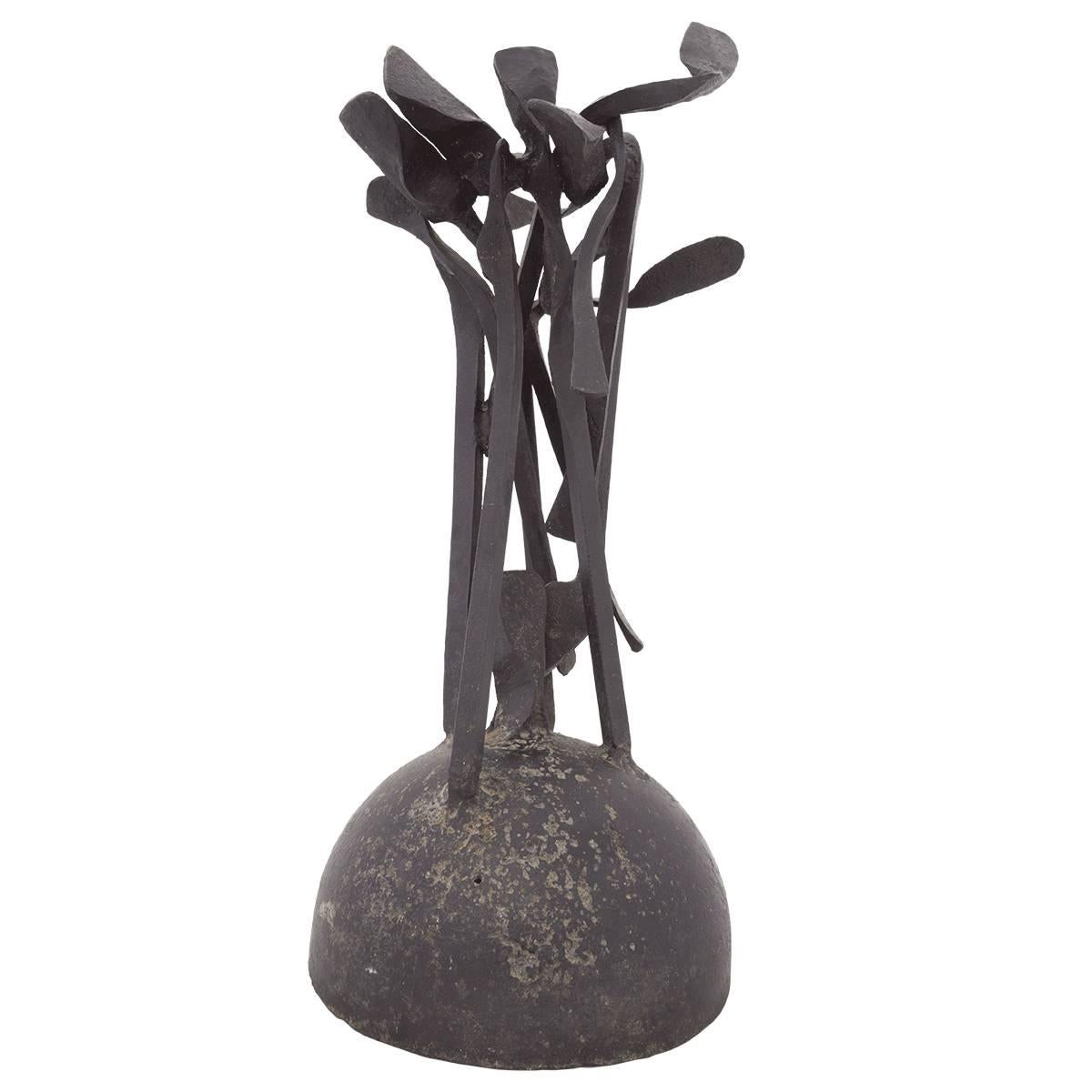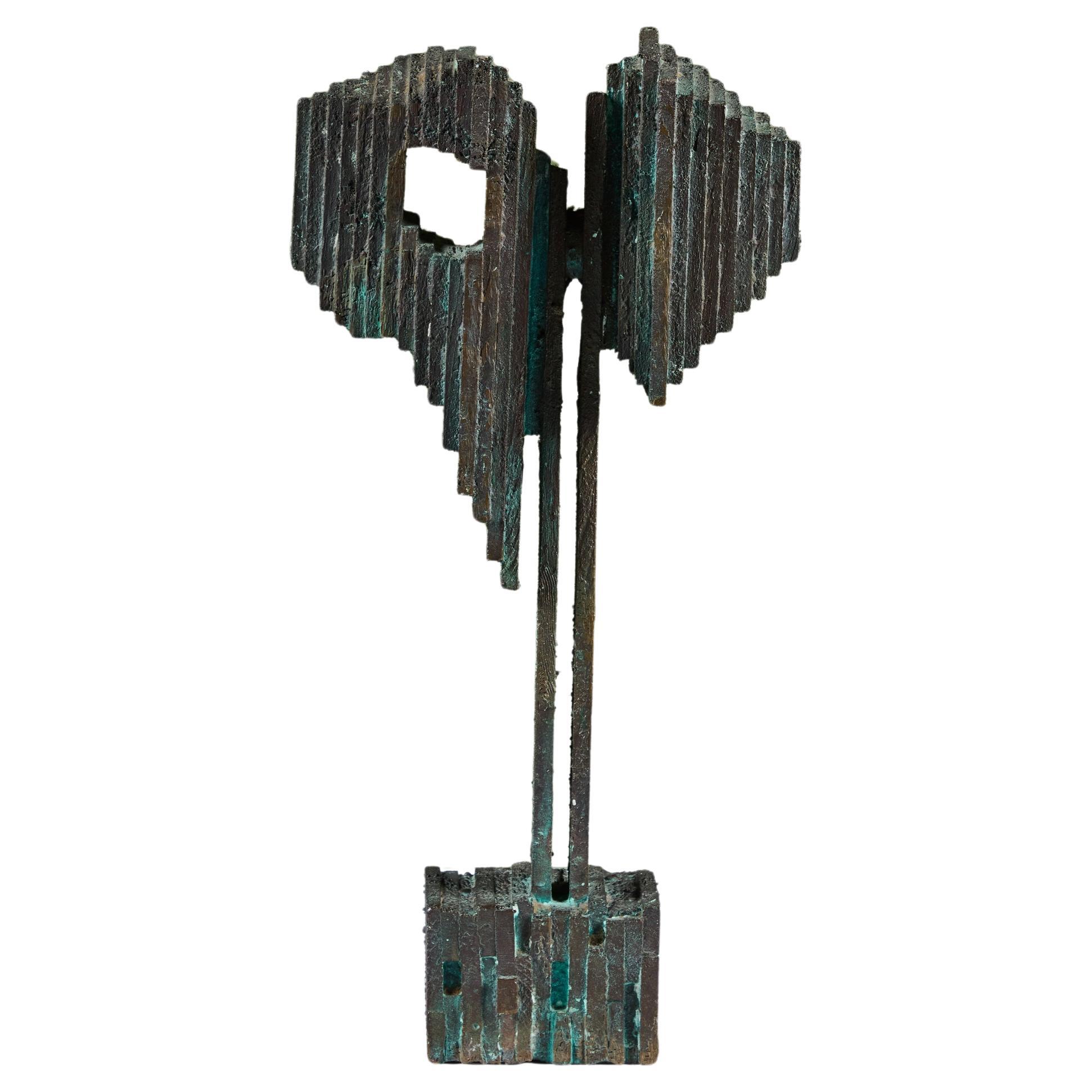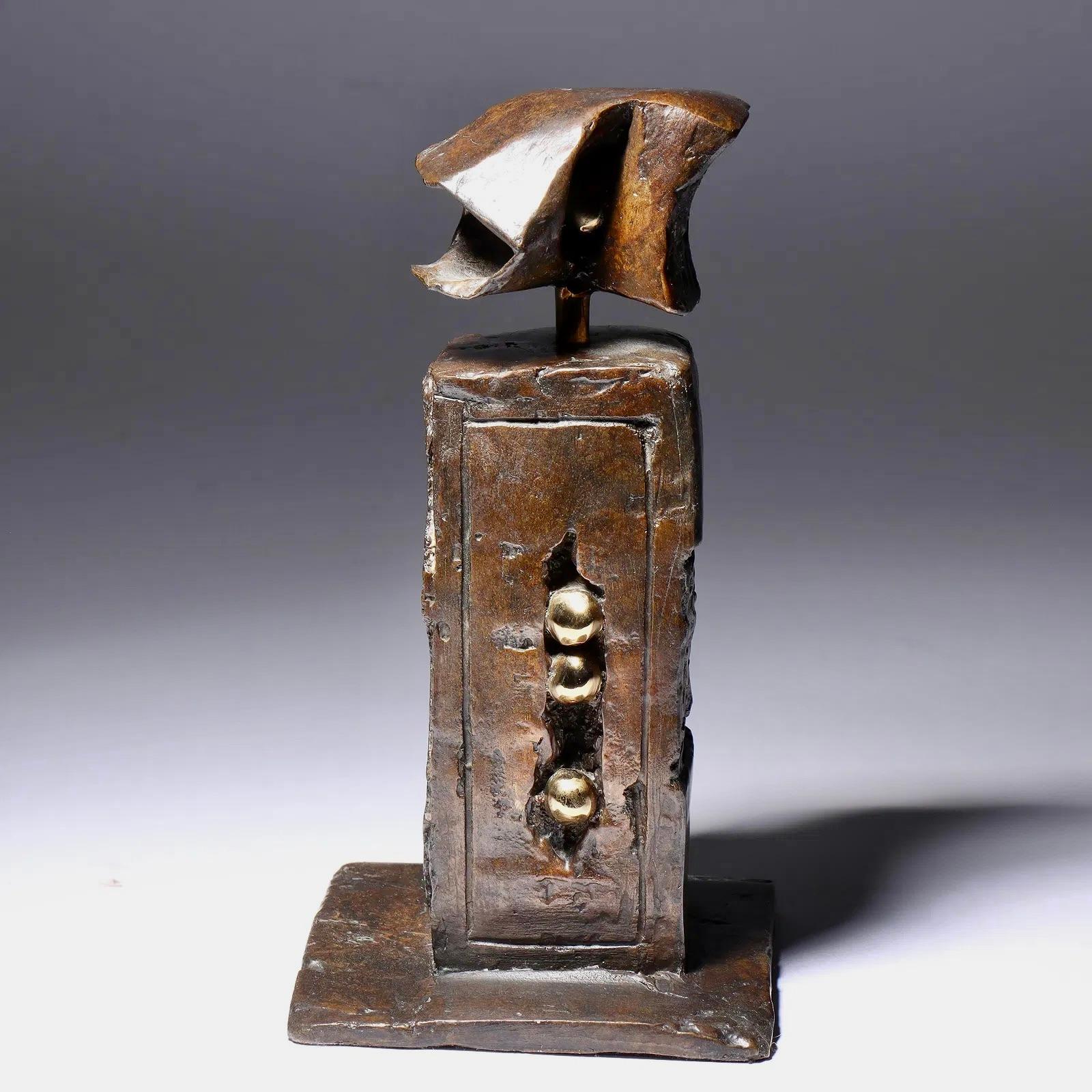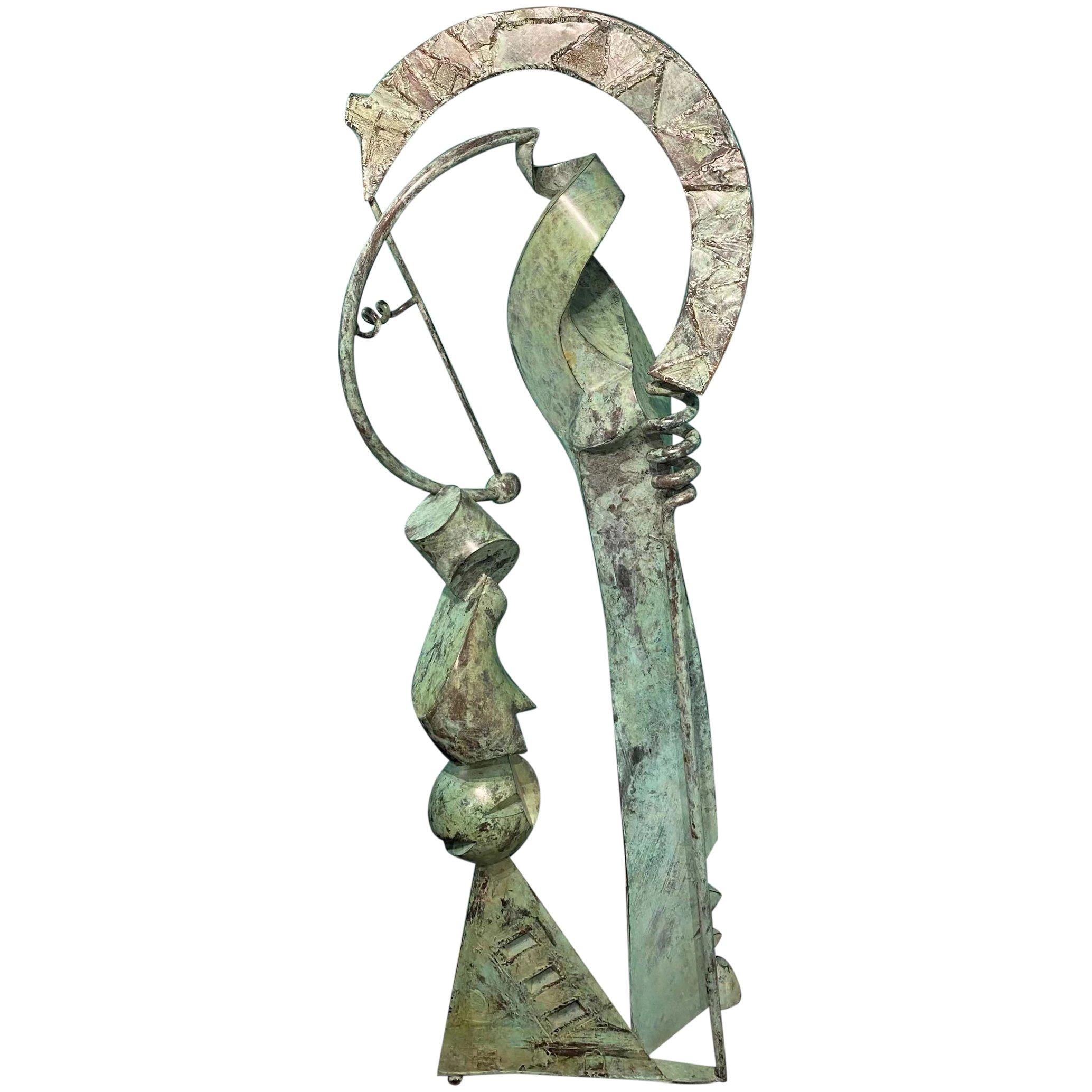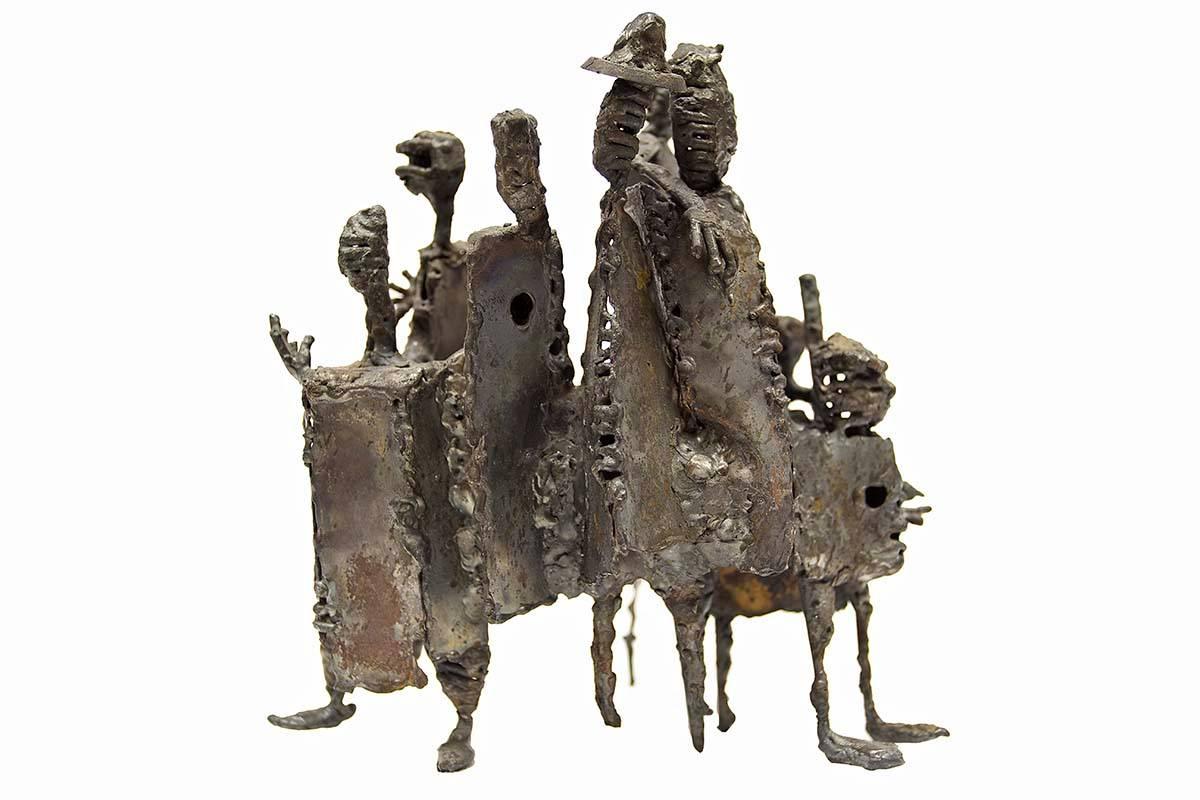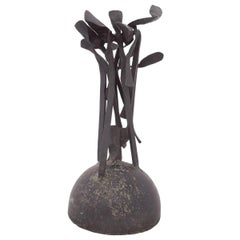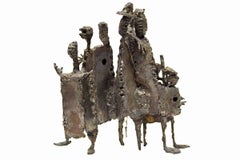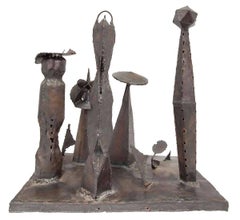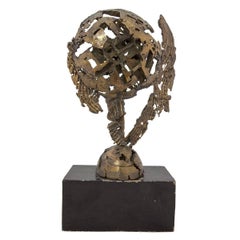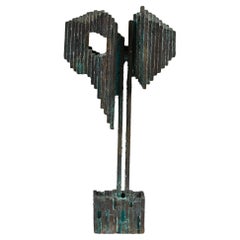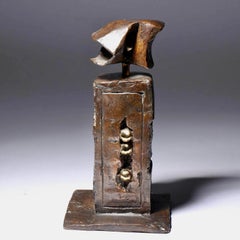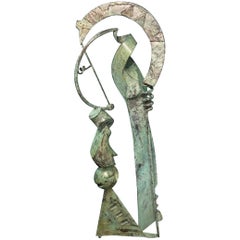Items Similar to Brutalist Bronze Abstract Modernist Sculpture
Want more images or videos?
Request additional images or videos from the seller
1 of 5
UnknownBrutalist Bronze Abstract Modernist Sculpture
$2,000
£1,504.81
€1,738.54
CA$2,826.52
A$3,069.05
CHF 1,625.29
MX$37,617.80
NOK 20,113.58
SEK 19,006.27
DKK 12,975.73
About the Item
In the manner of Julio Gonzalez, mixed metal sculpture.
Neo-Dada Abstract Sculpture: Assemblages
Abstract sculpture followed a slightly different course. Rather than focusing on non-figurative subject matter, it concentrated on materials, hence the emergence of Assemblage Art - a form of three-dimensional visual art made from everyday objects, said to be 'found' by the artist (objets trouves). Popular in the 1950s and 1960s in America, assemblage effectively bridged the gap between collage and sculpture, while its use of non-art materials - a feature of Neo-Dada art - anticipated the use of mass-produced objects in Pop-Art. Assemblage sculpture is exemplified by the works of Louise Nevelson (1899-1988), such as Mirror Image 1 (1969, Museum of Fine Arts, Houston), and by Jean Dubuffet (1901-85) and his Monument with Standing Beast (1960, James R. Thompson Center, Chicago). The idiom was considerably boosted by an important exhibition - "The Art of Assemblage" - at the Museum of Modern Art, in New York, in 1961.
Other examples of the Neo-Dadaist-style "junk art" include Hudson River Landscape (1951, Whitney Museum of American Art) and Australia (1951, MoMA, NY), both by David Smith (1906-1965); Untitled (wood, metal pieces, nails) (1960, Museum of Modern Art NYC) by Jesus Rafael Soto (b.1923); and certain "combines" by Robert Rauschenberg (1925-2008), such as First Landing Jump (made from: painting, cloth, metal, leather, electric fixture, cable, oil paint, board) (1961, MoMA, NY). Untitled (industrial felt) (1967, Kunsthalle, Hamburg) by Robert Morris (b.1931) is a further example of the use of unusual materials in sculpture, as is the minimalist Monument For Vladimir Tatlin (neon-lighting tubes) (1975, Musee National d'Art Moderne, George Pompidou Centre) by Dan Flavin (1933-96).
Dada also exalted nonsense-art, and what is more absurd than a sculpture that self-destructs? No doubt this was an important element in the philosophy behind the work of Jean Tinguely (1925-91), the unsurpassed master of self-destructing sculpture, whose masterpiece is generally reckoned to be Homage to New York (1960, Museum of Modern Art, New York).
An excellent example of abstract pop sculpture is the word art genre adopted by Robert Indiana (b.1928) in his series of LOVE sculptures.
Abstract Metal Sculpture (1960-onwards)
The 1960s also witnessed the beginning of a new broad tradition of metal sculpture, ranging from the portable to the monumental. Such works included: Sculpture For a Large Wall (1956-7, MoMA, NY) by Ellsworth Kelly (b.1923); Midday (1960, MoMA, NY) by Sir Anthony Caro (1924-2013); Die (1962, MoMA, NY) by Tony Smith (1912-1980); Broken Obelisk (1963-9, MoMA, NY) by Barnett Newman (1905-70); Storm Angel (1973-4, Square Chabas, Chalon-sur-Saone) by Mark Di Suvero (b.1933); and a number of works by Eduardo Chillida (1925-2002), culminating in his coastline sculpture Wind Comb (1977, Bay of San Sebastian, Spain).
- Dimensions:Height: 15 in (38.1 cm)Width: 18 in (45.72 cm)
- Medium:
- Movement & Style:
- Period:
- Condition:
- Gallery Location:Surfside, FL
- Reference Number:1stDibs: LU38210934722
About the Seller
4.9
Platinum Seller
Premium sellers with a 4.7+ rating and 24-hour response times
Established in 1995
1stDibs seller since 2014
1,807 sales on 1stDibs
Typical response time: 1 hour
- ShippingRetrieving quote...Shipping from: Surfside, FL
- Return Policy
Authenticity Guarantee
In the unlikely event there’s an issue with an item’s authenticity, contact us within 1 year for a full refund. DetailsMoney-Back Guarantee
If your item is not as described, is damaged in transit, or does not arrive, contact us within 7 days for a full refund. Details24-Hour Cancellation
You have a 24-hour grace period in which to reconsider your purchase, with no questions asked.Vetted Professional Sellers
Our world-class sellers must adhere to strict standards for service and quality, maintaining the integrity of our listings.Price-Match Guarantee
If you find that a seller listed the same item for a lower price elsewhere, we’ll match it.Trusted Global Delivery
Our best-in-class carrier network provides specialized shipping options worldwide, including custom delivery.More From This Seller
View AllMid Century Modern Brutalist Welded Abstract Expressionist Sculpture
Located in Surfside, FL
Neo-Dada Abstract Sculpture: Assemblages
In contrast, abstract sculpture followed a slightly different course. Rather than focusing on non-figurative subject matter, it concentrated...
Category
Mid-20th Century Abstract Expressionist Abstract Sculptures
Materials
Metal
Mid Century Modern Brutalist Welded Expressionist Sculpture
Located in Surfside, FL
In this bronze sculpture the artist (unknown) has welded together a group of figures into a unified piece. These figures take on animal, and human characteristics, which is evident i...
Category
Mid-20th Century Abstract Expressionist Abstract Sculptures
Materials
Metal
Mid Century Modern Brutalist Welded Expressionist Sculpture After Paul Evans
Located in Surfside, FL
In this bronze sculpture the artist (unknown) has welded together a group of totems or monuments into a unified piece. T
Neo-Dada Abstract Sculpture: Assemblages
In contrast, abstra...
Category
Mid-20th Century Abstract Expressionist Abstract Sculptures
Materials
Metal
Italian Modernist Bronze Brutalist Sculpture (Manner of Pomodoro)
Located in Surfside, FL
Large Modern Brutalist bronze sculpture in Manner of Arnaldo or Gio Pomodoro. We cannot locate a signature or any markings. it has an abstract quality to it. heavily textured with or...
Category
1950s Modern Abstract Sculptures
Materials
Bronze
Abstract Expressionist Biomorphic Welded Metal Sculpture
By Seymour Lipton
Located in Surfside, FL
Welded, brazed sculpture on wooden base
This is not signed or dated
This work is unsigned. We were told it was the work of Seymour Lipton but as there is further documentation we are selling it as attributed and cannot guarantee it as such.
Seymour Lipton (1903 – 1986) was an American abstract expressionist sculptor. He was a member of the New York School who gained widespread recognition in the 1950s. He initially trained as a dentist, like fellow sculptor Herbert Ferber, receiving his degree from Columbia University in 1927. In the late 1920s, he began to explore sculpture, creating clay portraits of family members and friends. His early choices of medium changed from wood to lead and then to bronze, and he is best known for his work in metal. Like his contemporary, Abstract Expressionist Jackson Pollock, and Arshile Gorky Lipton was influenced by Carl Jung’s work on the unconscious mind and the regenerative forces of nature. He translated these two-dimensional drawings into three-dimensional maquettes that enabled him to revise his ideas before creating the final sculpture. The forms that Lipton produced during this period were often zoomorphic, exemplifying the tension between the souls of nature and the automatism of the machine. He made several technical innovations, including brazing nickel silver rods onto sheets of Monel to create rust resistant forms. Seymour Lipton is best known for his textured torch welded metal sculptures...
Category
1950s Abstract Expressionist Abstract Sculptures
Materials
Metal
1965 Canadian Israeli Art Brutalist Abstract Welded Steel Sculpture Eli Ilan
Located in Surfside, FL
Eli Ilan (אלי אילן), 1928-1982 was an Israeli sculptor.
Abstract organic pod shape. in either steel or iron mounted on a wooden plinth.
Ilan was born in Winnipeg, Manitoba. He enrolled in a premedical curriculum at the University of British Columbia in Vancouver and emigrated to Israel in 1948. He then studied prehistoric archaeology and physical anthropology at the Hebrew University of Jerusalem. In 1956, he returned to Canada to study sculpture at the Ontario College of Art & Design. He lived in Kibbutz Sasa from 1959 to 1963. He died in 1982 in Caesarea, Israel.
Education
1955 Hebrew University, Jerusalem, pre-historic archaeology and physical anthropology
1956 Ontario College of Art, Toronto, Canada, sculpture under Thomas Bowie
1959 Training College, Ottawa, criminal identification techniques
1969 Art Festival, Painting & Sculpture in Israel. Ganei Hataarucha, Tel Aviv
Artists: Chana Orloff, Eli Ilan, Zvi Aldouby, Jacob El Hanani, Ludwig Blum, Aharon Bezalel, Koki Doktori, Israel Hadany, Marcel Janco, Dov Feigin, Abel Pann, Esther Peretz Arad, Reuven Rubin, Ivan Schwebel, Jakob Steinhardt, Boris Schatz, Bezalel (Lilik) Schatz, Louise Schatz...
Category
1960s Abstract Abstract Sculptures
Materials
Stainless Steel
You May Also Like
Eugene Caples "Bronze Sculpture II" Abstract Bronze Sculpture
By Eugene Caples
Located in Detroit, MI
This small exquisite "Bronze Sculpture II" is in excellent condition and a perfect example of Eugene Caples craftsmanship. This is mainly abstract with some graphic or architectural elements and is so delightful that mythical creatures demand to be considered. It cries out to be touched and held, looked at and caressed. The beautiful patina on the surface gives voice to the many hands that have done these things.
Eugene Caples is a designer and craftsman who worked in Kansas City in the 1960s and later through the early 21st century. He attended the Kansas City Art Institute, earning his Bachelors of Fine Arts in Industrial Design in 1959. In 1963 he was accepted to Cranbrook Academy of Art, Bloomfield Hills, Michigan. The Cranbrook Academy of Art was designed by architect and faculty member, Eliel Saarinen who collaborated with Charles and Ray Eames on chair and furniture design. Numerous creative artists are alumni of Cranbrook and include: Harry Bertoia, Florence Knoll, Jack Lenor Larsen, Donald...
Category
Late 20th Century American Modern Abstract Sculptures
Materials
Bronze
Abstract Bronze Sculpture
Located in Los Angeles, CA
Bronze mounted abstract sculpture. The sculpture showcases a square base and narrow stem that expands outwards to the right and left showcasing a layered look. One side appears to be...
Category
Mid-20th Century American Mid-Century Modern Abstract Sculptures
Materials
Bronze
Personnage Abstract Bronze Sculpture
By James Coignard
Located in Lake Worth Beach, FL
Personnage Patinated Bronze
Artist signed edition 7/24
JAMES COIGNARD (1925-2008)
Painter of still lifes; Mised Media Painter; Collages; Sculptor; Engraver; Expressionistic style, l...
Category
1970s Abstract Expressionist Abstract Sculptures
Materials
Marble, Bronze
Modernist Abstract Sculpture
Located in Milford, NH
A wonderful large modernist abstract bronze sculpture with geometric shapes by American artist Rodger Allen Mack (1938-2002). Mack was born in Barberton, Ohio, graduated from the Cle...
Category
20th Century Abstract Expressionist Abstract Sculptures
Materials
Bronze
Small Bronze Abstract Sculpture
Located in Los Angeles, CA
Original artwork.
One-of-a-kind.
Hammered and welded thin cut strips of bronze on wood base.
Great for decor and collections of modern art.
No signature.
Category
Mid-20th Century American Modern Abstract Sculptures
Materials
Bronze
An Abstract Steel Metal Sculpture, "Untitled Steel Sculpture"
Located in San Diego, CA
A one of a kind 3" x 18" x 4" Abstract Steel Metal Sculpture executed by artist James Hubbell. A certificate of authenticity will be provided upon its purchase.
James Hubbell is an...
Category
2010s Abstract Abstract Sculptures
Materials
Steel
More Ways To Browse
Abstract Bronze Sculpture Bronze
Vintage Metal Abstract Sculpture
Modernist Bronze
20th Century Modernist Sculpture
Unusual Sculpture
Wind Sculpture
Copper Brutalist Sculpture
Neon Tube
Modern Jesus
Dior Caro
Alison Brannen
Ceramics Kaneko
Chad Sculpture
Chihuly Macchia
Contemporary Doll Sculpture
Eduardo Villa
Fake London
Infinity Bronze Sculpture
